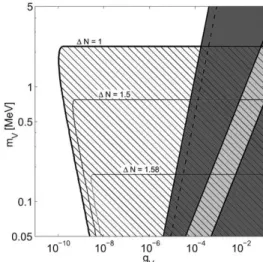arXiv:1309.0991v1 [hep-ph] 4 Sep 2013
Comment on “Is Dark Matter with Long-Range Interactions a Solution to
All Small-Scale Problems of
ΛCDM Cosmology?”
Bj¨orn Ahlgren,∗ Tommy Ohlsson,† and Shun Zhou‡
Department of Theoretical Physics, KTH Royal Institute of Technology, 106 91 Stockholm, Sweden
In a recent Letter [1], van den Aarssen et al. sug-gested a general scenario for dark matter, where both the dark-matter particle χ and ordinary neutrinos ν interact with an MeV-mass vector boson V via L ⊃ gχχγ
µχV
µ+ gννγ µνV
µ with gχ and gν being the
corre-sponding coupling constants. Given a vector-boson mass 0.05 MeV . mV .1 MeV, one needs 10−5 .gν .0.1
to solve all the small-scale structure problems in the sce-nario of cold dark matter [1].
Recently, Laha et al. [2] found that the ν-V interaction might lead to too large decay rates of K−→µ−+ ν
µ+ V
and W−→l−+ ν
l+ V , indicating that the scenario
pro-posed in Ref. [1] is severely constrained. However, such experimental bounds can be evaded if the longitudinal polarization state of V is sterile or if V is coupled to sterile neutrinos rather than ordinary ones [1, 2].
Now, we show that the constraints on gν and mV from
Big Bang Nucleosynthesis (BBN) are very restrictive. In the early Universe, V can be thermalized via the inverse decay ν + ν → V and pair annihilation ν + ν → V + V and contribute to the energy density. If the inverse-decay rate exceeds the expansion rate H around the tempera-ture T = 1 MeV, we obtain gν > 1.5 × 10−10 MeV/mV
for mV . 1 MeV. For mV ≪ 1 MeV, pair
annihila-tion is more efficient than inverse decay to thermalize V . Requiring the annihilation rate Γpair ∝ gν4T > H, one
obtains gν > 3.4 × 10−5. For mV > 1 MeV, however,
even if V is in thermal equilibrium, its number density will be suppressed by a Boltzmann factor. To derive the BBN bound, we first solve the non-integrated Boltzmann equation for the distribution function of V for given gν
and mV, where only the decay and inverse-decay
pro-cesses are included in the computations [3–7]. Then, we calculate its energy density, and require the extra number of neutrino species ∆Nν < 1 at T = 1 MeV [8]. Thus,
we can exclude a large region of the parameter space, as shown in Fig. 1. The contribution from V in ther-mal equilibrium reaches its maximum ∆Nν≈1.71 in the
relativistic limit.
Note that we have assumed ∆Nν to be constant, but
for mV > 1 MeV it actually decreases during the BBN
era, so our constraint should be somehow relaxed in the large-mass region. Since only the transverse polarizations of V are involved in inverse decay in the limit of zero neutrino masses, the BBN constraint does not depend on whether the longitudinal polarization is thermalized or not. If neutrinos are Dirac particles, the right-handed neutrinos νRcan be in thermal equilibrium as well. Both
V and νR contribute to the energy density, so one or
more species of νRis obviously ruled out. In addition, if
V is coupled to sterile neutrinos, which are supposed to be thermalized, the BBN bound on gν and mV becomes
more stringent.
FIG. 1: Constraints on gνand mV from K decays (gray, solid
line), W decays (gray, dashed line), and BBN. The two former are reproduced from Ref. [2], and the sample region in Fig. 3 of Ref. [1] is also presented (light gray). The hashed region
bounded by the thick solid curve is excluded by ∆Nν < 1
at 95% C.L. [8]. The excluded region will shrink for ∆Nν<
1.5 (see, e.g., Ref. [9]), and even further for the “maximally
conservative” limit ∆Nν.1.58 for mV >0.05 MeV.
We are grateful to Torsten Bringmann for valuable communication. Financial support from the Swedish Re-search Council and the G¨oran Gustafsson Foundation is acknowledged.
∗ Electronic address: bjornah@kth.se
† Electronic address: tohlsson@kth.se
‡ Electronic address: shunzhou@kth.se
[1] L.G. van den Aarssen, T. Bringmann and C. Pfrommer, Phys. Rev. Lett. 109, 231301 (2012).
[2] R. Laha, B. Dasgupta and J.F. Beacom, arXiv:1304.3460. [3] E.W. Kolb and M.S. Turner, The Early Universe, Front.
Phys. 69, 1 (1990).
[4] M. Kawasaki, G. Steigman and H.-S. Kang, Nucl. Phys. B 403, 671 (1993).
2
[6] J. Garayoa, S. Pastor, T. Pinto, N. Rius and O. Vives, JCAP 0909, 035 (2009).
[7] F. Hahn-Woernle, M. Pl¨umacher and Y.Y.Y. Wong, JCAP
0908, 028 (2009).
[8] G. Mangano and P.D. Serpico, Phys. Lett. B 701, 296
(2011).
[9] J. Hamann, S. Hannestad, G.G. Raffelt and Y.Y.Y. Wong, JCAP 1109, 034 (2011).
